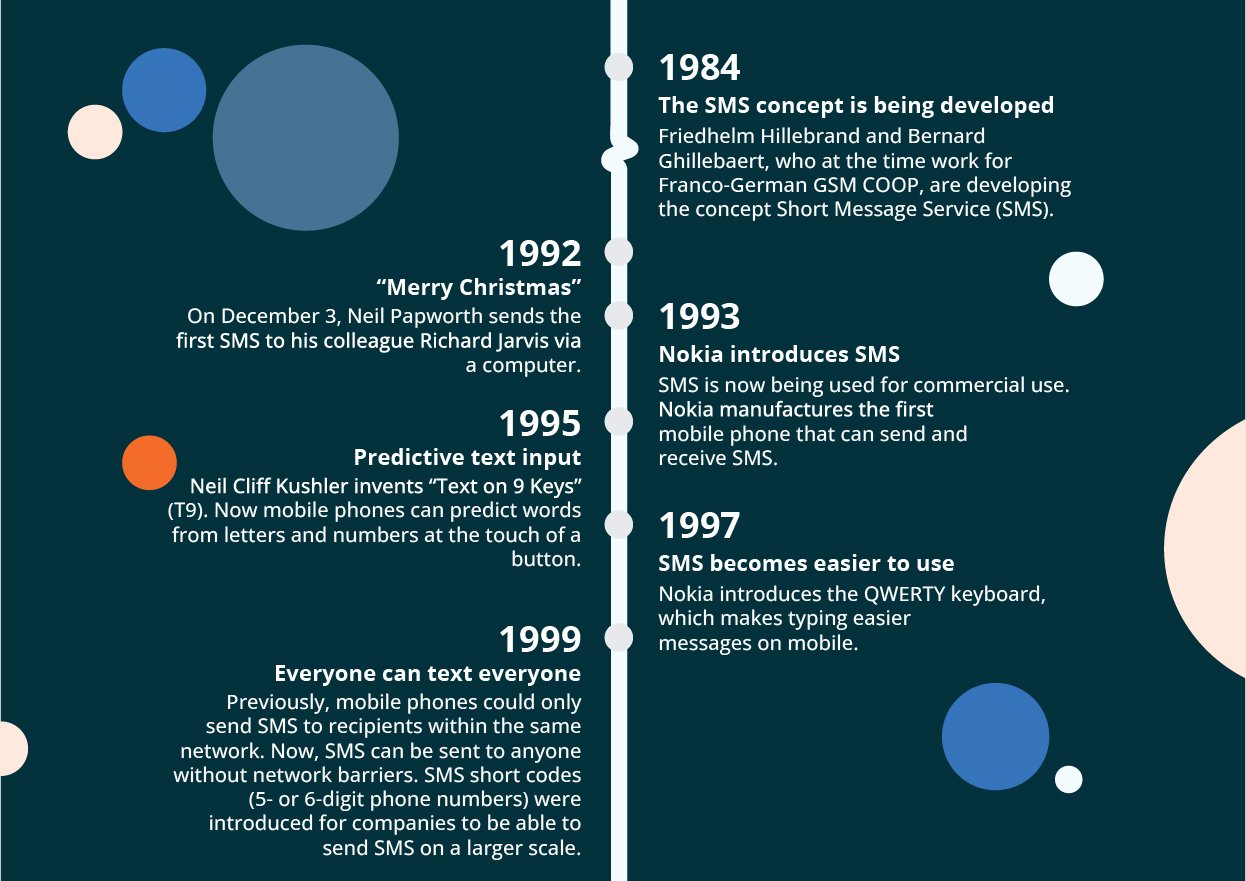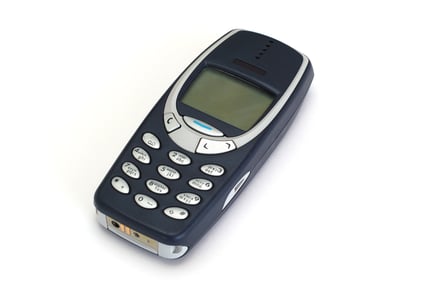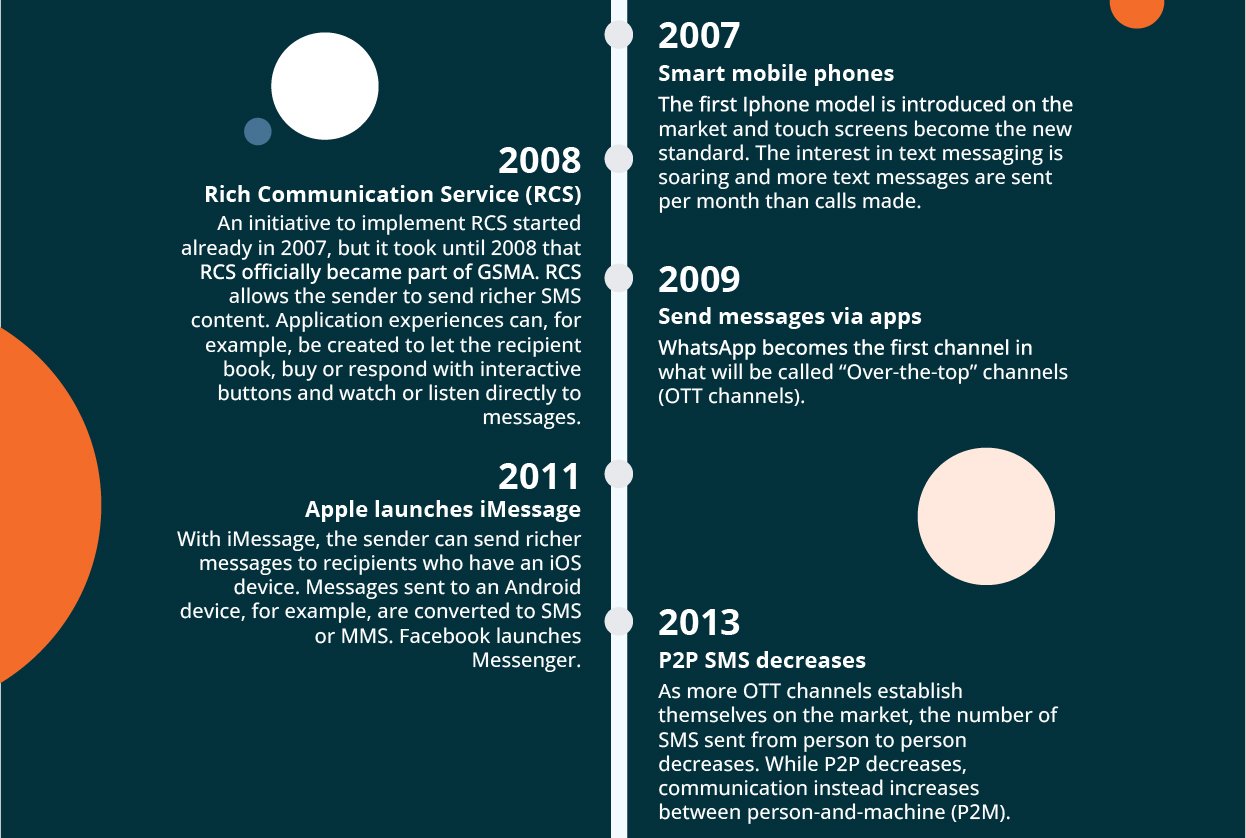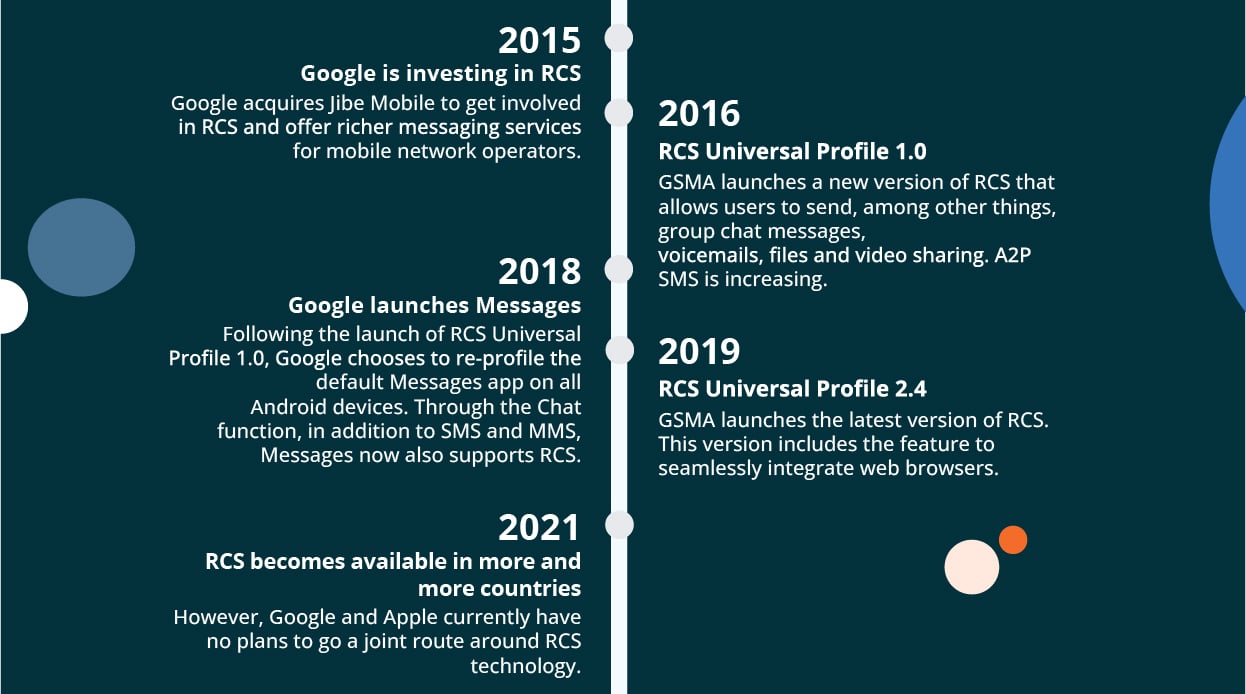We have been sending messages to each other since time immemorial. Initially through cuneiform and thousands of years later today through SMS and other similar messaging services. Today, there are a plethora of different messaging services that have further developed SMS technology - a technology that was originally developed in the early 1980s. So how did we end up with all these alternative messaging channels? To find out, we first need to travel back in time to the technological revolution of the 1980s.
The 1980s accounted for inventions that would revolutionize how we communicate with each other. Some of the inventions were; the first PC with a graphical interface developed by IBM, the first laptop by Adam Osborne, and towards the middle of the decade Short Message Service (SMS) was developed. In 1982, the CEPT Group GSM was formed to develop a standard for mobile telephony systems in Europe. In 1984, the technology was ready to see the light. Behind the technology were in particular the German Friedhelm Hillebrand and the Frenchman Bernard Ghillebaert, both active in the Franco-German cooperative Global System for Mobile Communications (GSM).
Some believe that SMS technology was originally invented by Finnish students who discussed the possibility of being able to communicate with text through different mobile stations. That SMS would become a standardized technology for global mobile communication is, however, stated not to have been on the students' minds at the time. According to the authors of the book Short Message Service (2010), a meeting took place in 2009 between the founders of SMS to discuss the origins of the service. Some of the participants were the developers Friedhelm Hillebrand, Matti Makkonen, Finn Trosby, and Thomas Beijer. The meeting concluded that the intention of the Finnish developers was to create a system for handling messages like E-mail. Something that GSM achieved in the end.

Behind GSM was the European Telecommunications Standards Institute (ETSI), a European independent non-profit organization focusing on supporting development in information and communication. Today, the organization collaborates with associated countries around the world, including the United States, Canada, Brazil, China, India, and South Africa. Since the new mobile communication system was intended to be used globally through the 900 MHz-frequency band (which is still used today for 3G and 4G in Sweden), it was important that countries collaborated so that basic functions could be standardized. For example, it would not be possible to send an SMS if the recipient has a SIM card that does not work in the same network terminal. GSM's task was thus to agree on which functions would be standardized in the mobile communication system.
The intention with SMS was initially to make it possible for recipients to be informed about messages they received in their voicemail. However, it was not until 1992 that the first text message was sent.
”Merry Christmas”
This was the first text message sent from Neil Papworth to Richard Jarvis. At the time, Papworth worked for the IT company Sema Group, whose customer at the time was the telecommunications company Vodafone, where Jarvis worked. However, the historic first SMS was not sent between two phones, but between a computer and a phone. As the technology was not yet fully developed, Jarvis could not respond to Papworth's message. It took another year before SMS became commercially viable and this was thanks to developers from Finland.

Why did SMS become so popular?
In 1994, the Finnish company Nokia became the first provider of mobile phones that could send and receive SMS. The following year, Neil Cliff Kushler developed "Text on 9 Keys" (T9). With T9, mobile phones could now predict words from letters and numbers at the touch of a button, which made it easier to write sentences and send messages. In 1997, Nokia introduced the QWERTY desktop, which made it even easier to write messages on mobile phones. At the same time, roaming was now available internationally and all newer mobile phones were thus capable of sending and receiving SMS. SMS was a convenient way to send messages to each other and this led to increasingly younger users opening their eyes to the service. As a result, SMS usage increased a lot.
Network operators also saw the possibilities with SMS. The authors of the book Short Message Service (2010) believe that SMS, just like Telex, was highly appreciated by network operators because of its profitability. When GSM defined the standard for SMS, it was with the idea that network operators would not have the exclusive right to SMS because it would prevent the possibilities for the service to be further developed. During the late 1990s, telecom companies carefully studied the development of SMS and also companies outside the telecom industry began to see opportunities in reaching their customers with SMS.
In 1999, SMS short codes were introduced on the market, this allowed companies to send bulk SMS with five- or six-digit numbers. With shorter numbers, it was faster to send SMS to a larger group of recipients. It also became easier for consumers to distinguish between numbers from companies and from friends and family. You can read more about how you can interact with your customers through personal short codes here.
By the end of the 1990s, SMS had far from reached its full potential, and it still has not, as there were restrictions on how much text could be sent.
160 characters
Since SMS technology was originally intended to transmit messages over existing signaling paths in the telephony system, the length of the message was limited. Because the signal paths have limited throughput, it was not possible to transmit more than 160 characters. The character limit applies to messages encoded with the GSM-7 character set. If the message is not coded with GSM-7, the limit is 70 characters. The limit of 160 characters still remains today and the character limit also laid the foundation for Twitter's limit of 140 characters when users write a post.
Another limitation that SMS initially had was storage. The early SIM cards could only receive 5-10 SMS before the recipient had to delete messages to make room for new ones. The SIM cards could at the time store between 32 KB and 128 KB. Over time, the space for memory storage has increased and today the data is stored in the mobile's own storage memory or in a storage cloud. An iPhone 13 sold today has 128 GB of storage set as standard.
SMS or text message?
The term text message or abbreviated text originates from the 1970s when communication in text form mainly took place with the help of tools such as Telex, Teletex, and Telefax. Telefax was also the business that LEKAB started with in 1996 when SMS was still an embryo in a larger context. When SMS became widely used in the mid-1990s, the terms text message, as well as SMS, were popularly interpreted as an abbreviation for Short Message Service. In other words, the terms today can be interpreted synonymously with each other and create the meaning of sending or receiving an SMS.
E-mail to SMS
Already in the 1990s, solutions were tested to be able to send messages from E-mail to SMS, as well as SMS to E-mail and SMS to fax. SMS to fax never made an impact commercially, but E-mail to SMS was more successful. In the 1990s, on the other hand, the process was much more complicated than it is today. First, the name-based E-mail needed to be converted to the number-based address system in which SMS is based, something that today is done easily with an API / Gateway. Since SMS can only receive 160 characters, while E-mail has no character limit, a system for converting longer messages also needed to be developed. Today, with the help of a cloud service, you can easily convert E-mail to SMS or vice versa and send messages to address lists, groups, and other.

Multimedia Message Service (MMS)
The beginning of the 2000s not only gave us the 3G network, but also the ability to send pictures, videos, and emojis to each other with the mobile phone. The new technology was developed by the 3rd Generation Partnership Project (3GPP) and Wireless Application Protocol (WAP) between 1999–2002 and was named MMS. At first, it was a slow process to implement the technology on the market, which was largely due to mobile operators collaborating internationally to make MMS more secure than SMS.
However, MMS has a couple of challenges compared to SMS. First and foremost, the user must be connected to the internet to be able to send and receive an MMS. Then the content and appearance of each mobile phone may differ from each other, which means that in some cases the recipient can not receive exactly the same content as the sender originally sent. Read more about how you can personalize mailings to your customers.
SMS short codes in American Idol
The following year, 2003, people were able to vote for their idols on the TV screen for the first time with the help of SMS short codes. The American television program American Idol was the first to implement SMS as a way of voting to decide a winner of the competition.

The new era – smart mobile phones
In 2007, development progressed at a rapid pace when Apple introduced the first smartphone - iPhone. The buttons on the iPhone were now gone and instead, the desktop was virtual. With the new smart mobile phones, new applications, so-called apps, began to be created to give the user an expanded experience in the mobile. The Internet, therefore, began to play a greater role for mobile users - which also led to a higher subscription cost for most households. In 2007, for the first time, more SMS were sent per month than telephone calls were made.
In the same year, the technology for Rich Communication Service (RCS) began to be developed. In 2008, RCS officially became part of GSM to be developed into the new standard for text messaging. Then it would take over a decade before the technology finally could be implemented on the market. With RCS, the sender can send richer SMS content with an application-based experience for the recipient.
Send text messages via apps
The WhatsApp app was created in 2009 and was initially not intended to be a messaging application, but a service to see the activity status of contacts in the mobile's address book. When Apple introduced notifications in the iOS operating system, the founders of WhatsApp saw the opportunity to further develop the app and allow users to send SMS-like messages to each other on their mobile. WhatsApp was first in line to become a part of the new Over-The-Top channels (OTT channels).
Apple launches iMessage
In 2011, a new version of the Messages app was launched on iPhone under the new name iMessage. With iMessage, all users who have an iPhone can send more secure encrypted messages over wifi or mobile networks to each other. iMessage also gives users the ability to view read receipts, send group messages and files, among other things. Messages sent to recipients who do not have an iPhone, such as an Android, are converted to SMS or MMS. The same year, Facebook launched its own OTT channel Facebook Messenger.
In 2013, more and more OTT channels became established on the market, and consequently the number of SMS sent from person to person (P2P) decreased.

Google invests in RCS
Until 2015, Jibe Mobile had driven the development of RCS. At this point in time, Google would also begin to see potential in the new technology and therefore acquired Jibe Mobile. In 2016, GSMA launches a new version of RCS, RCS Universal Profile 1.0, which allows users to send group chat messages, voicemails, files, and share videos. In the same year, communication from application-to-person (A2P) and person-to-application (P2A) increases.
As a result of the new RCS update, Google chooses to re-profile the standard Messages app on Android mobile phones in 2018. With the new Chat feature, users can use RCS technology to send messages, but until now the feature is still only available in a few countries. In 2019, the United Kingdom and France became the first to be able to use RCS, and towards the end of the year, the technology would also be introduced in the United States.
2019 also launches the latest update of RCS - RCS Universal Profile 2.4. This version includes the feature to seamlessly integrate browsers into chat format. Since 2019, RCS has continued to be made available in more and more countries. However, there are some obstacles along the way that RCS needs to overcome before the technology can become available globally. One obstacle is that Google and Apple have not been able to agree on a common path around RCS technology, which creates issues since iOS users can not receive RCS messages from Android users and vice versa. Read more about how you can use RCS technology to convert and create a dialogue with your customers in completely new ways.
The future of messaging services?
SMS as a messaging service is still growing today but is constantly being challenged by old and new OTT channels, such as WhatsApp, Viber, and WeChat KakaoTalk, Telegram, Facebook Messenger, Line, imo and more. Today, the use of these channels is widespread geographically. For example, Facebook (WhatsApp & Messenger) and Apple (iMessage) dominate the market in the Western world, while Viber is used most frequently by users in Eastern Europe. In East Asia, KakaoTalk, WeChat, and Line dominate the market.

Messages sent from application-to-person (A2P) will most likely continue to increase. The most common uses include:
- SMS marketing and campaigns
- SMS confirmations and reminders
- 2-factor authentication
- Staffing
- Alarms and incidents
- Delivery notices and click & collect
To be able to send messages regardless of channel, a Gateway and API integration to an existing system or a communication platform may need to be used.
About LEKAB
LEKAB streamlines and automates mobile communication and business processes. We help companies, authorities, and regions on a daily basis to reach their recipients quickly and securely with important messages on their mobile phones, regardless of channel. Are you interested in our services and applications or want to ask us for advice? Contact Us!
